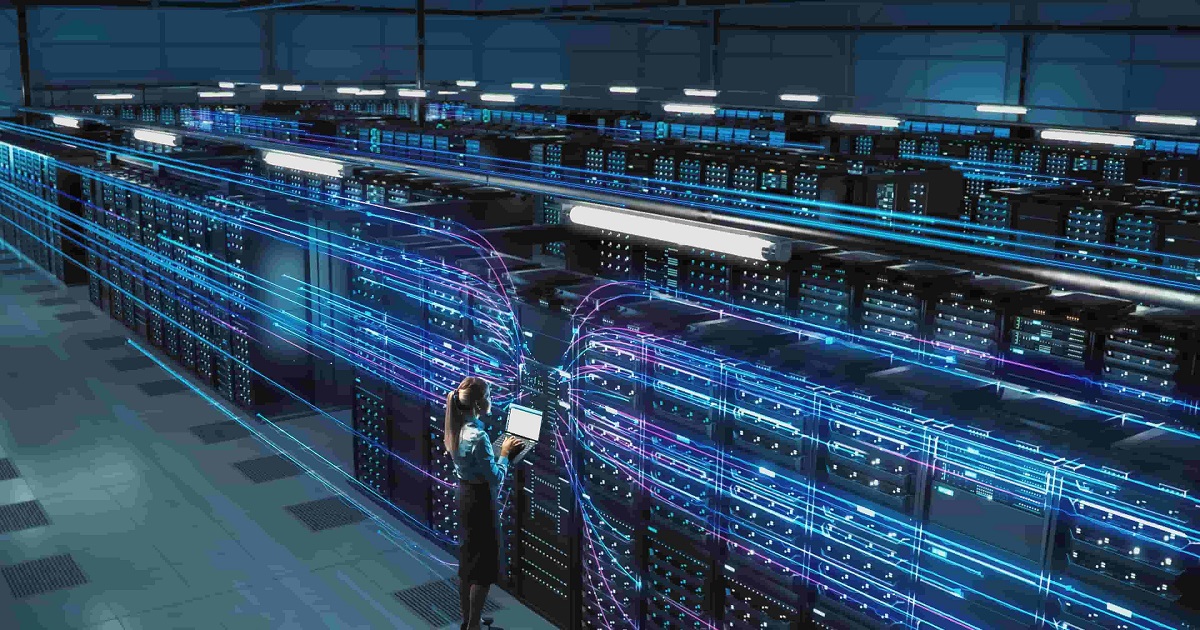
Hyper-Converged Infrastructure
Article | October 3, 2023
At last, the wait for 5G is nearly over. As this map shows, coverage is widespread across much of the U.S., in 24 EU countries, and in pockets around the globe.
The new wireless standard is worth the wait. Compared to 4G, the new wireless standard can move more data from the edge, with less latency. And connect many more users and devices—an important development given that the IDC estimates 152,000 new Internet of Things (IoT) devices per minute by 2025. Put it together, and 5G is a game-changing backhaul for public networks. (Wi-Fi 6, often mentioned in the same breath as 5G, is generally used for private WANs.
Read More

Application Storage, Data Storage
Article | July 12, 2023
Driving excellence in HCI: Unveil the crucial role of managed service providers in deploying and managing Hyper-Converged Infrastructure for optimal performance and efficiency for smooth functioning.
Contents
1. Introduction
2. Role of MSPs in Deployment of HCI
3. Role of MSPs in HCI’s Management
4. Key Areas Where MSPs Help Drive Efficient HCI
4.1. Expert Deployment and Configuration
4.2. Proactive Monitoring and Management
4.3. Performance Optimization
4.4. Security and Compliance
4.5. Patch Management and Upgrades
4.6. Scalability and Flexibility
4.7. Cost Optimization
4.8. 24/7 Support and Incident Management
5. Takeaway
1. Introduction
Fundamentally, a hyper-converged infrastructure comprises virtual computing, virtual hyperconverged network, and virtual SAB. However, deploying this infrastructure is a complex procedure that requires skill and attention. A managed service provider (MSP) can assist a business in implementing hyper-converged infrastructure. These are service providers that specialize in managing and maintaining hyper-converged infrastructure environments on behalf of businesses. They offer proactive monitoring, maintenance, and troubleshooting services to ensure optimal performance & availability and management excellence in HCI.
2. Role of MSPs in Deployment of HCI
Managed service providers play a crucial role in the successful deployment of Hyperconverged Infrastructure. With their expertise and experience, MSPs assist businesses in planning and designing the optimal HCI solution tailored to their needs. They manage the integration of hardware and software components, ensuring compatibility and seamless integration into the existing IT infrastructure. MSPs handle data migration and transition, minimizing downtime and data loss. They also optimize performance by fine-tuning configurations and resource allocations to achieve optimal HCI operation. MSPs prioritize security and compliance, implementing robust measures to protect sensitive data and ensure regulatory compliance. They provide ongoing management and support, monitoring system health, performing maintenance, and addressing issues promptly. MSPs enable scalability and future-proofing, helping businesses scale their HCI environment as needed and ensuring flexibility for future technology advancements and changes in business requirements. Broadly, MSPs bring their specialized knowledge and services to navigate the complexities of HCI deployment, enabling businesses to maximize the benefits of this transformative HCI technology.
3. Role of MSPs in HCI’s Management
Managed service providers play a crucial role in the effective management of HCI. MSPs offer a range of services to ensure the optimal performance and security of HCI environments. They proactively monitor and maintain the HCI infrastructure, identifying and addressing issues before they impact operations. MSPs specialize in performance optimization, fine-tuning configurations, and implementing load balancing techniques to maximize efficiency. They prioritize security and compliance by implementing robust measures and assisting with data backup and disaster recovery strategies. MSPs also assist with capacity planning and scalability, ensuring resources are efficiently allocated and businesses can adapt to changing demands. They provide 24/7 support, troubleshooting services, and comprehensive reporting and analytics for HCI management excellence. Additionally, MSPs handle vendor management, simplifying interactions with hardware and software providers. Overall,
MSPs enable businesses to effectively manage their HCI environments, ensuring smooth operations, optimal performance, and security.
4. Key Areas Where MSPs Help Drive Efficient HCI
Managed Service Providersplay a crucial role in driving deployment and management excellence in Hyperconverged Infrastructure (HCI) environments. HCI combines storage, compute, and networking into a single, software-defined platform, simplifying data center operations. Here's how MSPs contribute to HCI excellence:
1. Expert Deployment and Configuration
MSPs possess deep expertise in HCI deployments. They understand the complexities of hardware, software, and networking integration required for optimal HCI implementation. MSPs ensure proper configuration, capacity planning, and performance tuning to maximize HCI efficiency and meet specific business needs.
2. Proactive Monitoring and Management
MSPs provide proactive monitoring and management services, continuously monitoring the HCI environment to detect issues and resolve them before they impact performance or availability. They leverage advanced monitoring tools and technologies to monitor resource utilization, network connectivity, and storage performance, ensuring optimal HCI operation.
3. Performance Optimization
MSPs specialize in fine-tuning HCI performance. They analyze workloads, assess resource requirements, and optimize configurations to ensure optimal performance and scalability. Through proactive capacity planning and performance optimization techniques, MSPs help businesses extract the maximum value from their HCI investment.
4. Security and Compliance
MSPs prioritize security and compliance in HCI environments. They implement robust security measures, such as encryption, access controls, and threat detection systems, to protect critical data and ensure compliance with industry regulations. MSPs also assist businesses in implementing data backup and disaster recovery strategies to safeguard against potential data loss or system failures.
5. Patch Management and Upgrades
MSPs handle patch management and upgrades in HCI environments. They ensure that the HCI platform stays up to date with the latest security patches and software updates, minimizing vulnerabilities and ensuring hyperconverged system stability. MSPs coordinate and execute seamless upgrades, minimizing disruptions and maintaining optimal HCI performance.
6. Scalability and Flexibility
MSPs help businesses scale and adapt their HCI environments to meet changing demands. They assess growth requirements, optimize resource allocation, and implement expansion strategies to accommodate evolving business needs. MSPs enable businesses to scale their HCI infrastructure seamlessly without compromising performance or availability.
7. Cost Optimization
MSPs assist in optimizing costs associated with HCI deployments. They evaluate resource utilization, identify inefficiencies, and implement cost-saving measures, such as workload consolidation and resource allocation optimization. MSPs help businesses achieve maximum return on investment by aligning HCI infrastructure with specific business objectives.
8. 24/7 Support and Incident Management
MSPs offer round-the-clock support and incident management for HCI environments. They provide timely resolution of issues, minimizing downtime and ensuring continuous operation. MSPs also offer help desk services, ticket management, and proactive troubleshooting to address any challenges that arise in the HCI environment.
5. Takeaway
The future of managed service providers is promising and dynamic. MSPs will continue to enhance their specialized expertise in HCI, offering comprehensive support for businesses' HCI environments. They will expand their services to include end-to-end managed hyperconverged solutions, covering deployment, ongoing management, performance optimization, and security. Automation and orchestration will play a significant role as MSPs leverage these technologies to streamline operations and improve efficiency. MSPs will also focus on strengthening security and compliance measures, integrating HCI with cloud services, and continuously innovating to stay ahead in the HCI landscape. Broadly, MSPs will be vital partners for businesses seeking to maximize the benefits of HCI while ensuring smooth operations and staying competitive in the digital era.
MSPs in HCI offer specialized expertise, managed services, automation, AI-driven analytics, enhanced security and compliance, integration with hyper converged cloud services, and continuous innovation. Their services will cover the entire lifecycle of HCI, from deployment to ongoing management and optimization. MSPs will leverage automation and AI technologies to streamline operations, enhance security, and provide proactive monitoring and maintenance. They will assist businesses in integrating HCI with cloud services, ensuring scalability and flexibility. MSPs will continuously innovate to adapt to emerging technologies and industry trends, supporting businesses in harnessing the full potential of HCI and achieving their digital transformation goals.
Read More

Hyper-Converged Infrastructure, IT Systems Management
Article | September 14, 2023
Navigating the complex terrain of Hyper-Converged Infrastructure: Unveiling the best practices and innovative strategies to harness the maximum benefits of HCI for transformation of business.
Contents
1. Introduction to Hyper-Converged Infrastructure
1.1 Evolution and adoption of HCI
1.2 Importance of Adapting to the Changing HCI Environment
2. Challenges in HCI
2.1 Integration & Compatibility: Legacy System Integration
2.2 Efficient Lifecycle: Firmware & Software Management
2.3 Resource Forecasting: Scalability Planning
2.4 Workload Segregation: Performance Optimization
2.5 Latency Optimization: Data Access Efficiency
3. Solutions for Adapting to Changing HCI Landscape
3.1 Interoperability
3.2 Lifecycle Management
3.3 Capacity Planning
3.4 Performance Isolation
3.5 Data Locality
4. Importance of Ongoing Adaptation in the HCI Domain
4.1 Evolving Technology
4.2 Performance Optimization
4.3 Scalability and Flexibility
4.4 Security and Compliance
4.5 Business Transformation
5. Key Takeaways from the Challenges and Solutions Discussed
1. Introduction to Hyper-Converged Infrastructure
1.1 Evolution and adoption of HCI
Hyper-Converged Infrastructure has transformed by providing a consolidated and software-defined approach to data center infrastructure. HCI combines virtualization, storage, and networking into a single integrated system, simplifying management and improving scalability. It has gained widespread adoption due to its ability to address the challenges of data center consolidation, virtualization, and resource efficiency. HCI solutions have evolved to offer advanced features like hybrid and multi-cloud support, data deduplication, and disaster recovery, making them suitable for various workloads.
The HCI market has experienced significant growth, with a diverse ecosystem of vendors offering turnkey appliances and software-defined solutions. It has become the preferred infrastructure for running workloads like VDI, databases, and edge computing. HCI's ability to simplify operations, improve resource utilization, and support diverse workloads ensures its continued relevance.
1.2 Importance of Adapting to the Changing HCI Environment
Adapting to the changing Hyper-Converged Infrastructure is of utmost importance for businesses, as it offers a consolidated and software-defined approach to IT infrastructure, enabling streamlined management, improved scalability, and cost-effectiveness. Staying up-to-date with evolving HCI technologies and trends ensures businesses to leverage the latest advancements for optimizing their operations. Embracing HCI enables organizations to enhance resource utilization, accelerate deployment times, and support a wide range of workloads. In accordance with enhancement, it facilitates seamless integration with emerging technologies like hybrid and multi-cloud environments, containerization, and data analytics. Businesses can stay competitive, enhance their agility, and unlock the full potential of their IT infrastructure.
2. Challenges in HCI
2.1 Integration and Compatibility: Legacy System Integration
Integrating Hyper-Converged Infrastructure with legacy systems can be challenging due to differences in architecture, protocols, and compatibility issues. Existing legacy systems may not seamlessly integrate with HCI solutions, leading to potential disruptions, data silos, and operational inefficiencies. This may hinder the organization's ability to fully leverage the benefits of HCI and limit its potential for streamlined operations and cost savings.
2.2 Efficient Lifecycle: Firmware and Software Management
Managing firmware and software updates across the HCI infrastructure can be complex and time-consuming. Ensuring that all components within the HCI stack, including compute, storage, and networking, are running the latest firmware and software versions is crucial for security, performance, and stability. However, coordinating and applying updates across the entire infrastructure can pose challenges, resulting in potential vulnerabilities, compatibility issues, and suboptimal system performance.
2.3 Resource Forecasting: Scalability Planning
Forecasting resource requirements and planning for scalability in an HCI environment is as crucial as efficiently implementing HCI systems. As workloads grow or change, accurately predicting the necessary computing, storage, and networking resources becomes essential. Without proper resource forecasting and scalability planning, organizations may face underutilization or overprovisioning of resources, leading to increased costs, performance bottlenecks, or inefficient resource allocation.
2.4 Workload Segregation: Performance Optimization
In an HCI environment, effectively segregating workloads to optimize performance can be challenging. Workloads with varying resource requirements and performance characteristics may coexist within the HCI infrastructure. Ensuring that high-performance workloads receive the necessary resources and do not impact other workloads' performance is critical. Failure to segregate workloads properly can result in resource contention, degraded performance, and potential bottlenecks, affecting the overall efficiency and user experience.
2.5 Latency Optimization: Data Access Efficiency
Optimizing data access latency in an HCI environment is a rising challenge. HCI integrates computing and storage into a unified system, and data access latency can significantly impact performance. Inefficient data retrieval and processing can lead to increased response times, reduced user satisfaction, and potential productivity losses. Failure to ensure the data access patterns, caching mechanisms, and optimized network configurations to minimize latency and maximize data access efficiency within the HCI infrastructure leads to such latency.
3. Solutions for Adapting to Changing HCI Landscape
3.1 Interoperability
Achieved by: Standards-based Integration and API
HCI solutions should prioritize adherence to industry standards and provide robust support for APIs. By leveraging standardized protocols and APIs, HCI can seamlessly integrate with legacy systems, ensuring compatibility and smooth data flow between different components. This promotes interoperability, eliminates data silos, and enables organizations to leverage their existing infrastructure investments while benefiting from the advantages of HCI.
3.2 Lifecycle Management
Achieved by: Centralized Firmware and Software Management
Efficient Lifecycle Management in Hyper-Converged Infrastructure can be achieved by implementing a centralized management system that automates firmware and software updates across the HCI infrastructure. This solution streamlines the process of identifying, scheduling, and deploying updates, ensuring that all components are running the latest versions. Centralized management reduces manual efforts, minimizes the risk of compatibility issues, and enhances security, stability, and overall system performance.
3.3 Capacity Planning
Achieved by: Analytics-driven Resource Forecasting
HCI solutions should incorporate analytics-driven capacity planning capabilities. By analyzing historical and real-time data, HCI systems can accurately predict resource requirements and assist organizations in scaling their infrastructure proactively. This solution enables efficient resource utilization, avoids underprovisioning or overprovisioning, and optimizes cost savings while ensuring that performance demands are met.
3.4 Performance Isolation
Achieved by: Quality of Service and Resource Allocation Policies
To achieve effective workload segregation and performance optimization, HCI solutions should provide robust Quality of Service (QoS) mechanisms and flexible resource allocation policies. QoS settings allow organizations to prioritize critical workloads, allocate resources based on predefined policies, and enforce performance guarantees for specific applications or users. This solution ensures that high-performance workloads receive the necessary resources while preventing resource contention and performance degradation for other workloads.
3.5 Data Locality
Achieved by: Data Tiering and Caching Mechanisms
Addressing latency optimization and data access efficiency, HCI solutions must incorporate data tiering and caching mechanisms. By intelligently placing frequently accessed data closer to the compute resources, such as utilizing flash storage or caching algorithms, HCI systems can minimize data access latency and improve overall performance. This solution enhances data locality, reduces network latency, and ensures faster data retrieval, resulting in optimized application response times and improved user experience.
4. Importance of Ongoing Adaptation in the HCI Domain
continuous adaptation is of the utmost importance in the HCI domain. HCI is a swiftly advancing technology that continues to provide new capabilities. Organizations are able to maximize the benefits of HCI and maintain a competitive advantage if they stay apprised of the most recent advancements and adapt to the changing environment.
Here are key reasons highlighting the significance of ongoing adaptation in the HCI domain:
4.1 Evolving Technology
HCI is constantly changing, with new features, functionalities, and enhancements being introduced regularly. Ongoing adaptation allows organizations to take advantage of these advancements and incorporate them into their infrastructure. It ensures that businesses stay up-to-date with the latest technological trends and can make informed decisions to optimize their HCI deployments.
4.2 Performance Optimization
Continuous adaptation enables organizations to fine-tune their HCI environments for optimal performance. By staying informed about performance best practices and emerging optimization techniques, businesses can make necessary adjustments to maximize resource utilization, improve workload performance, and enhance overall system efficiency. Ongoing adaptation ensures that HCI deployments are continuously optimized to meet evolving business requirements.
4.3 Scalability and Flexibility
Adapting to the changing HCI landscape facilitates scalability and flexibility. As business needs evolve, organizations may require the ability to scale their infrastructure, accommodate new workloads, or adopt hybrid or multi-cloud environments. Ongoing adaptation allows businesses to assess and implement the necessary changes to their HCI deployments, ensuring they can seamlessly scale and adapt to evolving demands.
4.4 Security and Compliance
The HCI domain is not immune to security threats and compliance requirements. Ongoing adaptation helps organizations stay vigilant and up-to-date with the latest security practices, threat landscapes, and regulatory changes. It enables businesses to implement robust security measures, proactively address vulnerabilities, and maintain compliance with industry standards and regulations. Ongoing adaptation ensures that HCI deployments remain secure and compliant in the face of evolving cybersecurity challenges.
4.5 Business Transformation
Ongoing adaptation in the HCI domain supports broader business transformation initiatives. Organizations undergoing digital transformation may need to adopt new technologies, integrate with cloud services, or embrace emerging trends like edge computing. Adapting the HCI infrastructure allows businesses to align their IT infrastructure with strategic objectives, enabling seamless integration, improved agility, and the ability to capitalize on emerging opportunities.
The adaptation is thus crucial in the HCI domain as it enables organizations to stay current with technological advancements, optimize performance, scale infrastructure, enhance security, and align with business transformation initiatives. By continuously adapting to the evolving HCI, businesses can maximize the value and benefits derived from their HCI investments.
5. Key Takeaways from Challenges and Solutions Discussed
Hyper-Converged Infrastructure poses several challenges during the implementation and execution of systems that organizations need to address for optimal performance. Integration and compatibility issues arise when integrating HCI with legacy systems, requiring standards-based integration and API support.
Efficient lifecycle management is crucial, involving centralized firmware and software management to automate updates and enhance security and stability. Accurate resource forecasting is vital for capacity planning, enabling organizations to scale their HCI infrastructure effectively. Workload segregation demands QOS mechanisms and flexible resource allocation policies to optimize performance.
Apart from these, latency optimization requires data tiering and caching mechanisms to minimize data access latency and improve application response times. By tackling these challenges and implementing appropriate solutions, businesses can harness the full potential of HCI, streamlining operations, maximizing resource utilization, and ensuring exceptional performance and user experience.
Read More

Application Infrastructure
Article | December 15, 2021
The success of 5G technology is a function of both the infrastructure that supports it and the ecosystems that enable it. Today, the definitive focus in the 5G space is on enterprise use cases, ranging from dedicated private 5G networks to accessing edge compute infrastructure and public or private clouds from the public 5G network. As a result, vendor-neutral multitenant data center providers and their rich interconnection capabilities are pivotal in helping make 5G a reality. This is true both in terms of the physical infrastructure needed to support 5G and the ability to effectively connect enterprises to 5G.
Industry experts expect 5G to enable emerging applications such as virtual and augmented reality (AR/VR), industrial robotics/controls as part of the industrial internet of things (IIoT), interactive gaming, autonomous driving, and remote medical procedures. These applications need a modern, cloud-based infrastructure to meet requirements around latency, cost, availability and scalability. This infrastructure must be able to provide real-time, high-bandwidth, low-latency access to latency-dependent applications distributed at the edge of the network.
How Equinix thinks about network slicing
Network slicing refers to the ability to provision and connect functions within a common physical network to provide the resources necessary to deliver service functionality under specific performance constraints (such as latency, throughput, capacity and reliability) and functional constraints (such as security and applications/services). With network slicing, enterprises can use 5G networks and services for a wide variety of use cases on the same infrastructure.
Providing continuity of network slices with optimal UPF placement and intelligent interconnection
Mobile traffic originates in the mobile network, but it is not contained to the mobile network domain, because it runs between the user app on a device and the server workload on multi-access edge compute (MEC) or on the cloud. Therefore, to preserve intended characteristics, the slice must be extended all the way to where the traffic wants to go. This is why we like to say “the slicing must go on.”
The placement of network functions within the slice must be optimized relative to the intended traffic flow, so that performance can be ensured end-to-end. As a result, organizations must place or activate the user plane function (UPF) in optimal locations relative to the end-to-end user plane traffic flow.
We expect that hybrid and multicloud connectivity will remain a key requirement for enterprises using 5G access. In this case, hybrid refers to private edge computing resources (what we loosely call “MEC”) located in data centers—such as Equinix International Business Exchange™ (IBX®) data centers—and multicloud refers to accessing multiple cloud providers from 5G devices. To ensure both hybrid and multicloud connectivity, enterprises need to make the UPF part of the multidomain virtual Layer 2/Layer 3 interconnection fabric.
Because a slice must span multiple domains, automation of UPF activation, provisioning and virtual interconnection to edge compute and multicloud environments is critical.
Implementing network slicing for interconnection of core and edge technology
Equinix partnered with Kaloom to develop network slicing for interconnection of core and edge (NICE) technology within our 5G and Edge Technology Development Center (5G ETDC) in Dallas. NICE technology is built using cloud-native network fabric and high-performance 5G UPF from Kaloom. This is a production-ready software solution, running on white boxes built with P4 programmable application-specific integrated circuits (ASICs), allowing for deep network slicing and support for high-performance 5G UPF with extremely fast data transfer rates.
With NICE technology in the 5G ETDC, Equinix demonstrates:
5G UPF deployment/activation and traffic breakout at Equinix for multiple slices.
Software-defined interconnection between the 5G core and MEC resources from multiple providers.
Software-defined interconnection between the 5G core and multiple cloud service providers.
Orchestration of provisioning and automation of interconnection across the 5G core, MEC and cloud resources.
Architecture of NICE technology in the Equinix 5G ETDC
The image above shows (from left to right):
The mobile domain with radio access network (RAN), devices (simulated) and mobile backhaul connected to Equinix.
The Equinix domain with:
Equinix Metal® supporting edge computing servers and a fabric controller from Kaloom.
Network slicing fabric providing interconnection and Layer 2/Layer 3 cloud-native networking to dynamically activate UPF instances/interfaces connected with MEC environments and clouds, forming two slices (shown above in blue and red).
Equinix Fabric™ and multicloud connectivity.
This demonstrates the benefit of having the UPF as a feature of the interconnection fabric, effectively allowing UPF activation as part of the virtual fabric configuration. This ultimately enables high-performance UPF that’s suitable for use cases such as high-speed 5G fixed wireless access.
Combining UPF instances and MEC environments into an interconnection fabric makes it possible to create continuity for the slices and influence performance and functionality. Equinix Fabric adds multicloud connectivity to slices, enabling organizations to directly integrate network slicing with their mobile hybrid multicloud architectures.
Successful private 5G edge deployments deliver value in several ways. Primarily, they offer immediate access to locally provisioned elastic compute, storage and networking resources that deliver the best user and application experiences. In addition, they help businesses access a rich ecosystem of partners to unlock new technologies at the edge.
Secure, reliable connectivity and scalable resources are essential at the edge. A multivendor strategy with best-of-breed components complemented by telemetry, advanced analytics with management and orchestration—as demonstrated with NICE in Equinix data centers—is a most effective way to meet those requirements. With Equinix’s global footprint of secure, well-equipped facilities, customers can maximize benefits.”
- Suresh Krishnan, CTO, Kaloom
Equinix and its partners are building the future of 5G
NICE technology is just one example of how the Equinix 5G and Edge Technology Development Center enables the innovation and development of real-world capabilities that underpin the edge computing and interconnection infrastructure required to successfully implement 5G use cases. A key benefit of the 5G ETDC is the ability to combine cutting-edge innovations from our partners like Kaloom with proven solutions from Equinix that already serve a large ecosystem of customers actively utilizing hybrid multicloud architectures.
Read More